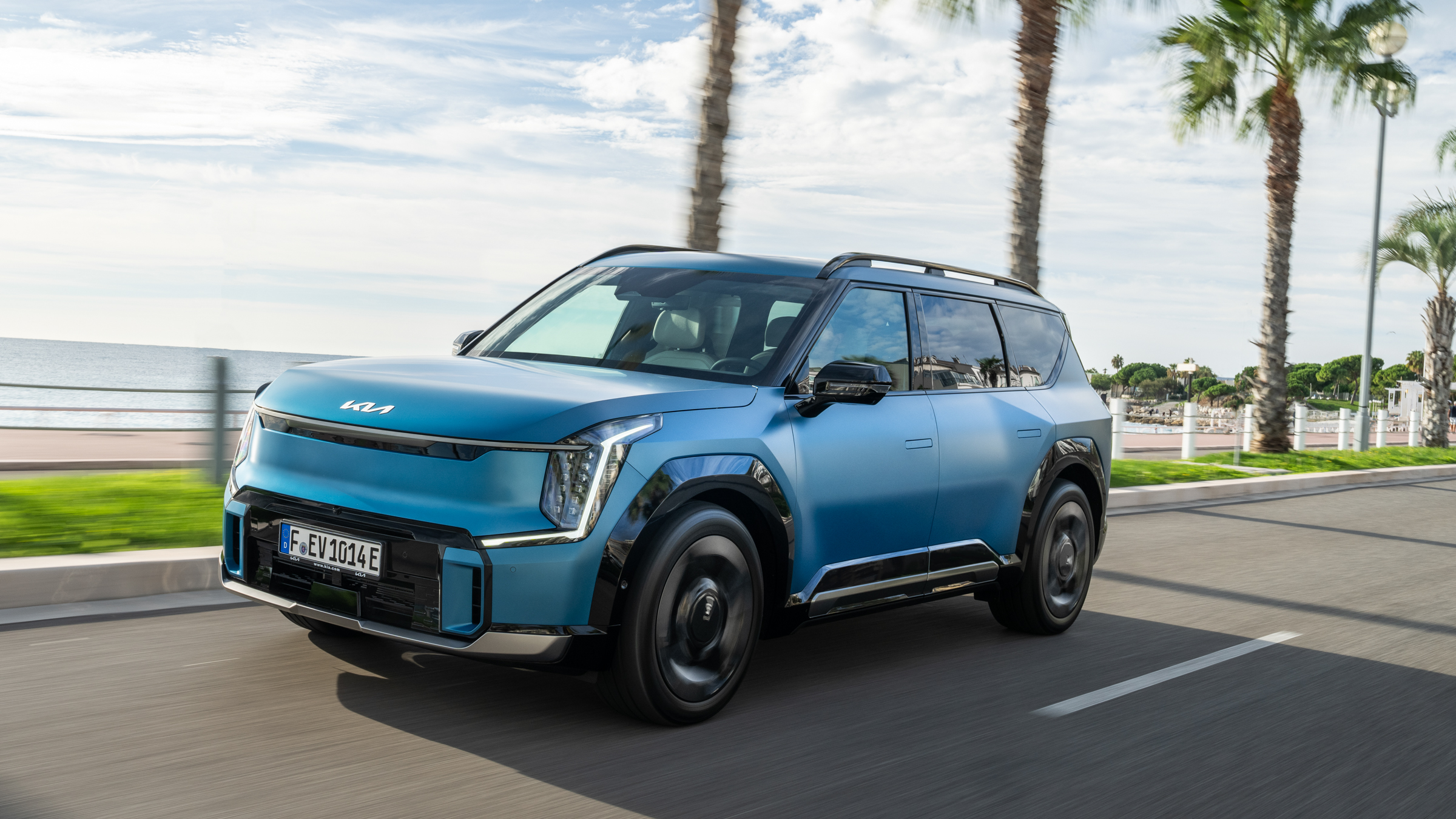
The EV9 is the new flagship of Kia’s electric car range. It’s a full-size SUV available with six or seven seats, promises a range of 350 miles from its huge, 99.8 kWh battery pack (weighing 566 kg all on its own, stat fans), and packs all of the fast-charging trickery we’ve come to expect from Kia’s smart 800-volt system architecture.
But while the tech is impressive, of equal importance here is how the EV9 takes Kia into a world where buyers of full-size electric SUVs aren’t used to seeing much change from £100,000. It’s a market soon to include the Volvo EX90 (from £96,255) and an upcoming all-electric Range Rover that is unlikely to come in below six figures.
The Kia EV9, on the other hand, starts at £64,995. Go all-in on the dual-motor GT-Line S variant with its plush swivelling seats and bonkers performance – 0-62 mph in 5.3 seconds, since you ask – and you’ll leave the showroom a full 20 grand better off than if you’d bought even the entry-level EX90.
Volvo will tell you it is a luxury car, but in a world where seemingly all EVs have seats made from recycled plastic bottles and double-glazed cabins as quiet as a church, the L-word isn’t as clearly defined as it once was. Factor in decreasing brand loyalty (and snobbery) among younger buyers more willing to shop Korean instead of European, and the EV9 looks like a bargain. Does it live up to expectations? T3 headed to the South of France to find out.
Price and availability
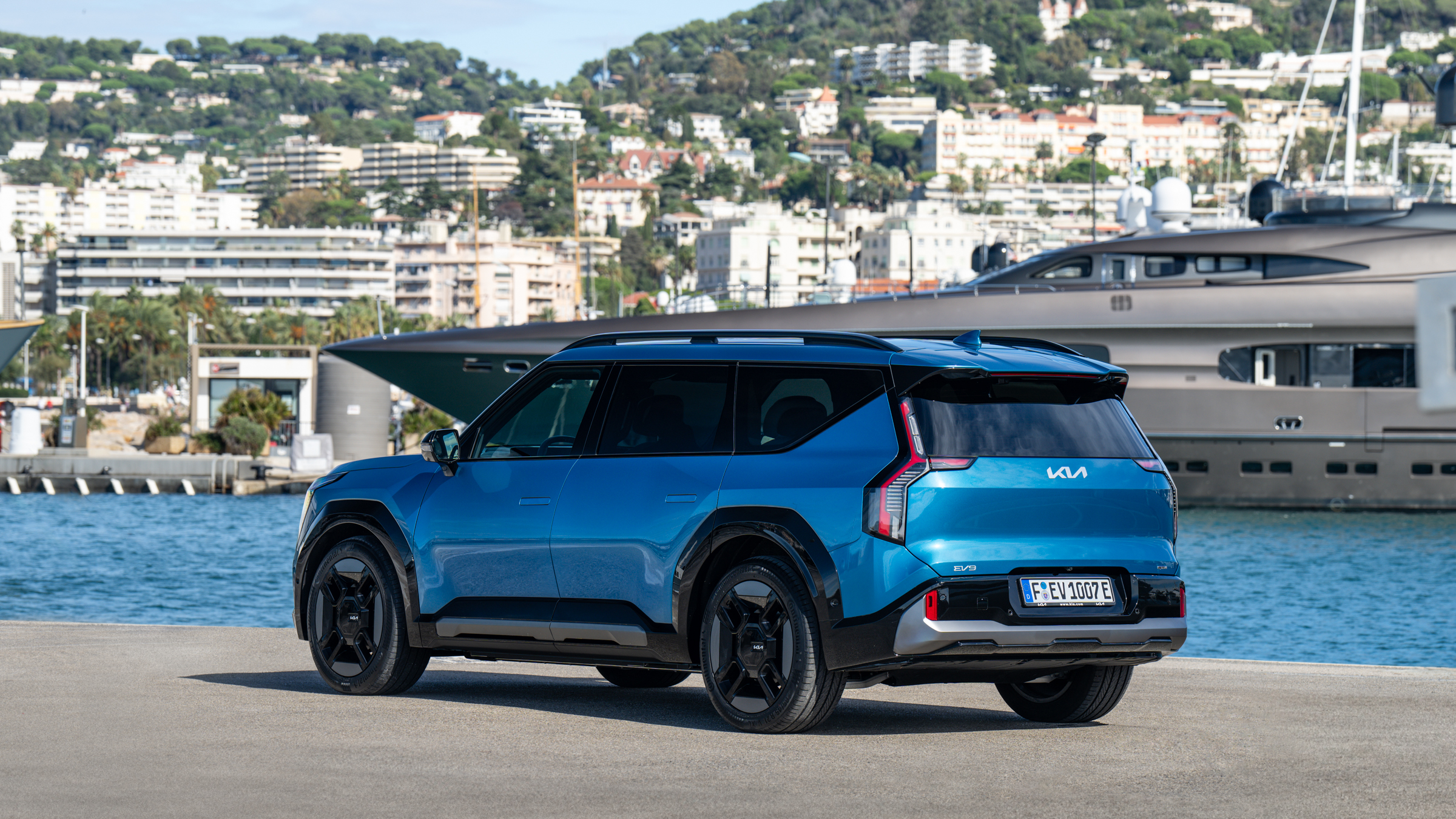
The Kia EV9 is available to order now, starting at £64,995 for the single-motor, rear-wheel-drive variant with entry-level ‘Air’ trim level. This is the only version of EV9 with one motor, which sends 200 bhp to the rear wheels, and at 349 miles it has the most range. Given all versions come with a wide range of features – including CarPlay, Android Auto, wireless phone charging, heated and ventilated front seats, automatic wipers, LED lights all round, dual-zone climate and much more – it’s the one to go for.
Unless you want the lovely Pacific Blue paint job of the car we drove here, in which case you’ll have to stump up at least £73,235 for the GT-Line model, plus an extra £725 for the paint.
The other three models all have a second motor powering the front axle and increasing the total output to 378 bhp. That extra motor also boosts torque from 350 Nm to 600 Nm, or a massive 700 Nm if you go for the Boost upgrade. Whichever way you slice it, the EV9 delivers a lot of bang for your buck.
Features and design
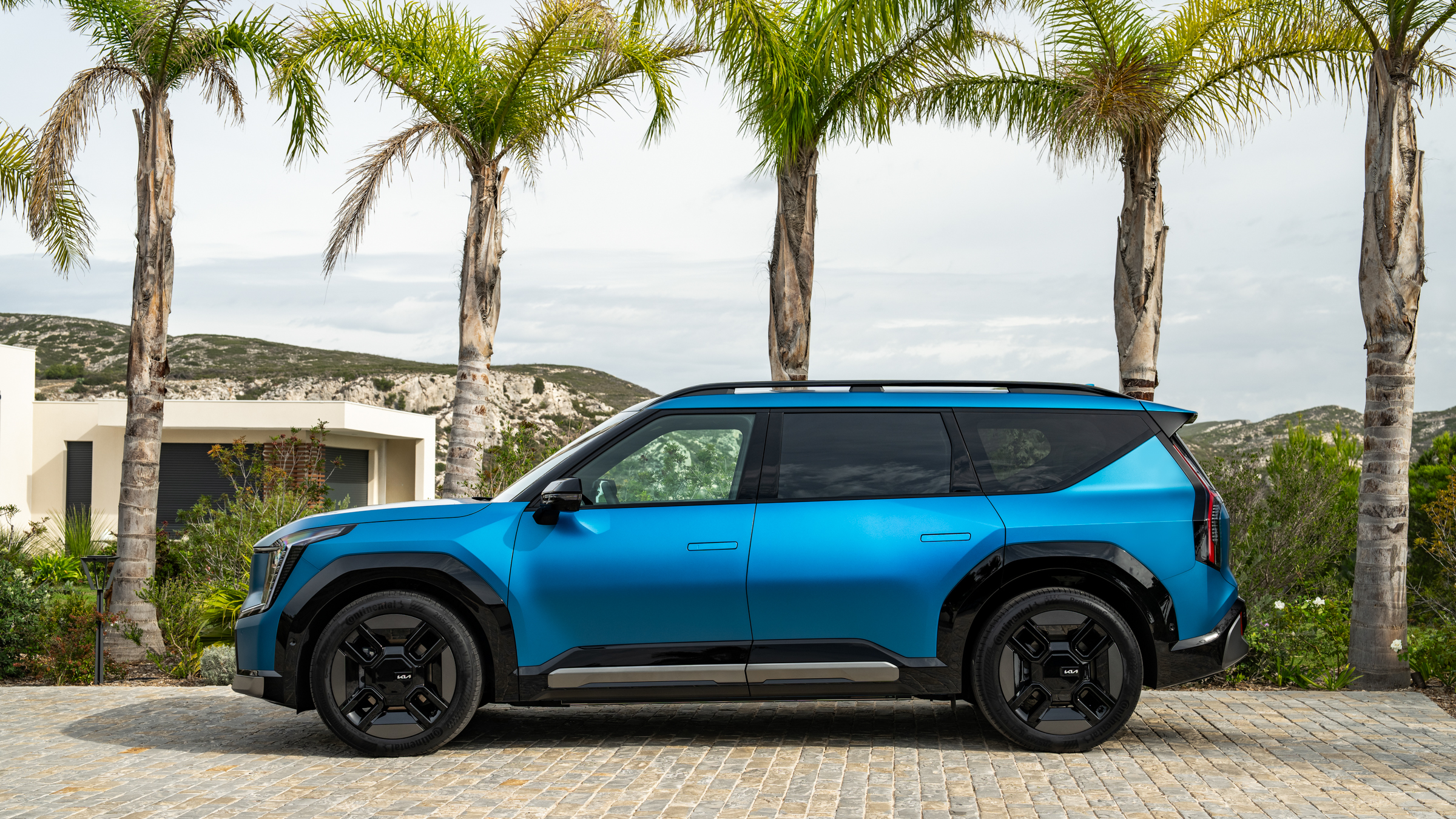
I love when the design of a concept car makes it into production. That’s just what has happened here with the EV9, which retains much of the concept’s sharp styling (seen in the second pic of this T3 story). The squared wheel arches are a particular highlight, along with the angular glasshouse and a sense that the EV9 comes from the future. Perhaps even another planet.
It’s sci-fi without shouting about it, and on the streets of St Tropez it spun heads in a way a ten-a-penny Range Rover simply wouldn’t. The Kia’s newness is playing a part here of course, but I can’t help wondering whether the recently redesigned Kia badge, criticised for looking like ‘KN’, inadvertently adds to the mystique.
The EV9 is available with six or seven seats, and with the second row capable of rotating 180 degrees for face-to-face rides, if that floats your passengers’ boat. Whichever way you spec it, it’s a big car. At 5,015 mm long, 2,262 mm wide with conventional mirrors instead of optional cameras and 1,750 mm tall, it’s very much a full-size SUV, and actually 5.3cm wider than a Range Rover. On the winding coastal roads of Kia’s test route it felt massive, and in London it simply won’t fit through some of the city’s width-restricted roads.
Actually, that’s a lie; with the 6ft 6 restriction of some roads being 1,981.2 mm you’ll have a roomy 0.6 mm on either side. With the mirrors folded in. I could rant about today’s cars no longer being fit for purpose – or indeed the roads they’re driven on – but I’ll save that for another day.
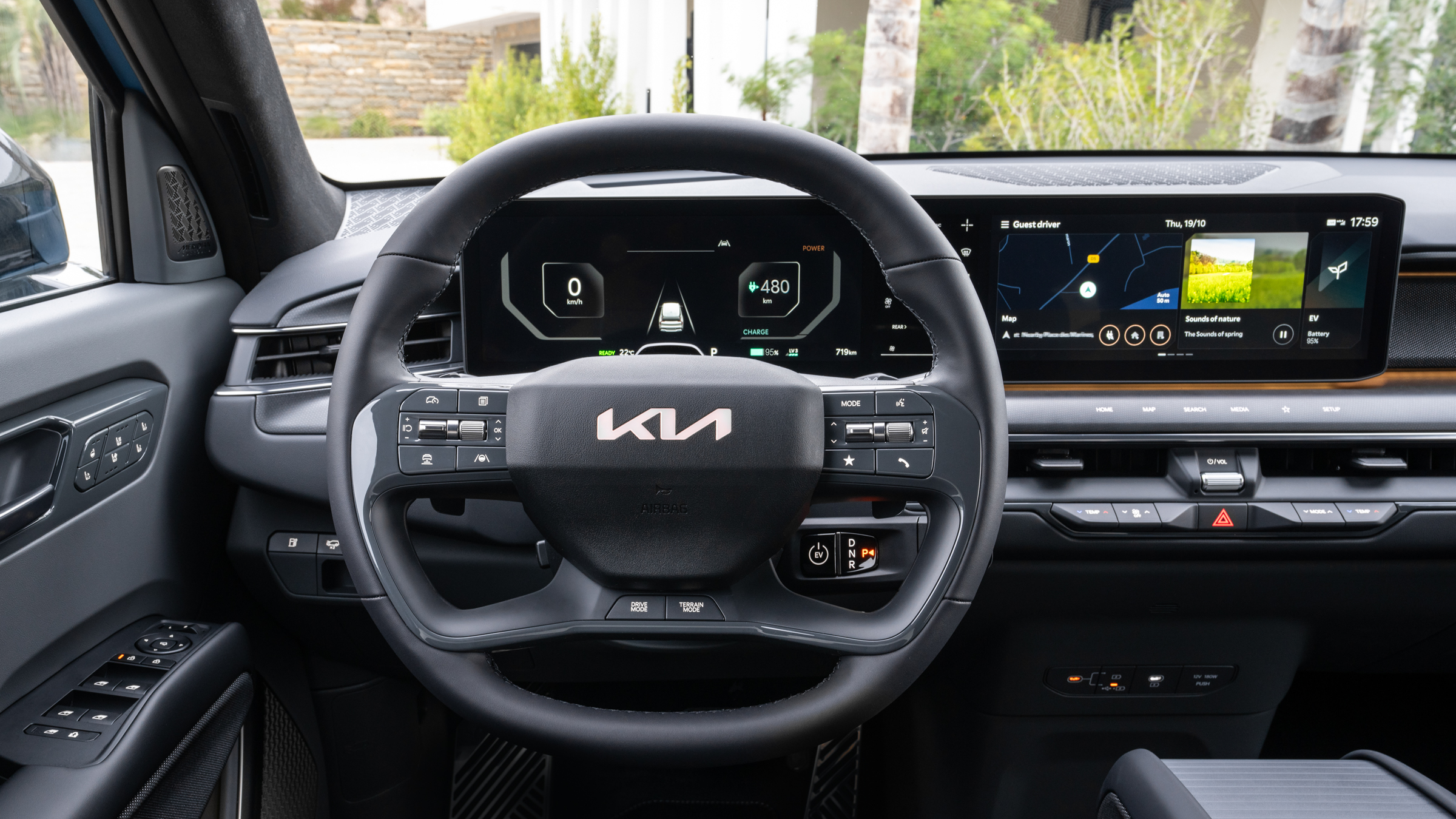
Step inside and there’s masses of space, of course, and plenty of light too. The seats are comfortable once you’ve got used to the slightly invasive driver's headrest and Kia has mercifully resisted relegating all buttons to the touch screen. It’s the exact opposite of the buttonless Volvo EX30, and while the Kia’s cabin can feel slightly overwhelming at first, the tactility of buttons, scroll wheels, knobs and switches makes their placement and action quicker to learn than the layers upon layers of touch screen submenus preferred by other cars.
Physical climate controls are very welcome indeed, along with two (two!) volume scroll wheels with integrated mute buttons. A row of what Kia calls ‘hidden buttons’ are less successful, since they don’t respond to a tap but also don’t offer a haptic click as precise as that of a MacBook Pro trackpad. Can't Apple just sell that tech to car companies? It'd make my year.

The 12.3in driver display is sharp and clear, and so too is the equally-sized infotainment screen in the centre of the cabin. Less successful is the new third display installed between them. This 5.3in touch panel is supposed to act as a convenient way to adjust the climate, but it is almost entirely blocked from view by the steering wheel and/or the driver’s hand.
It’s the sort of baffling ergonomics failure that today’s carmakers are increasingly guilty of, and in Kia’s case makes me wonder why the EV9 doesn’t use the same climate control system as the EV6. The climate controls can be expanded into the infotainment screen with a tap of a cross in the top-right corner. But given such an icon is universally used to close an interface window, it isn’t particularly intuitive.
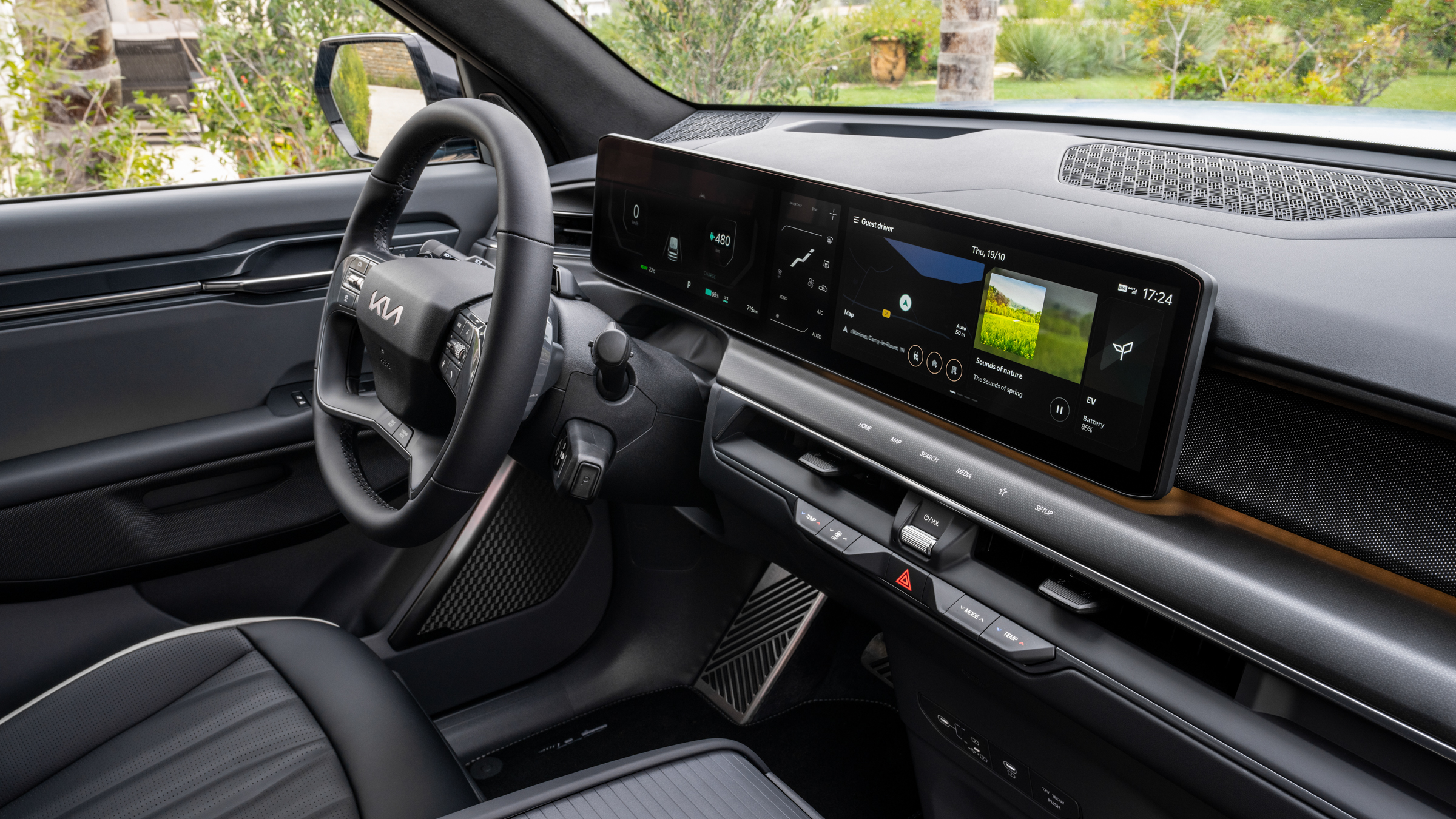
Welcome tech features include how your smartphone can be used as a key using NFC, Bluetooth Low Energy or Ultra-wideband, and how there’s a fingerprint reader on the centre console for driver authentication. There's also a 14-speaker Meridian Premium sound system fitted as standard, which is plenty powerful and sounds great, and the volume automatically adjusts with vehicle speed.
Performance and handling
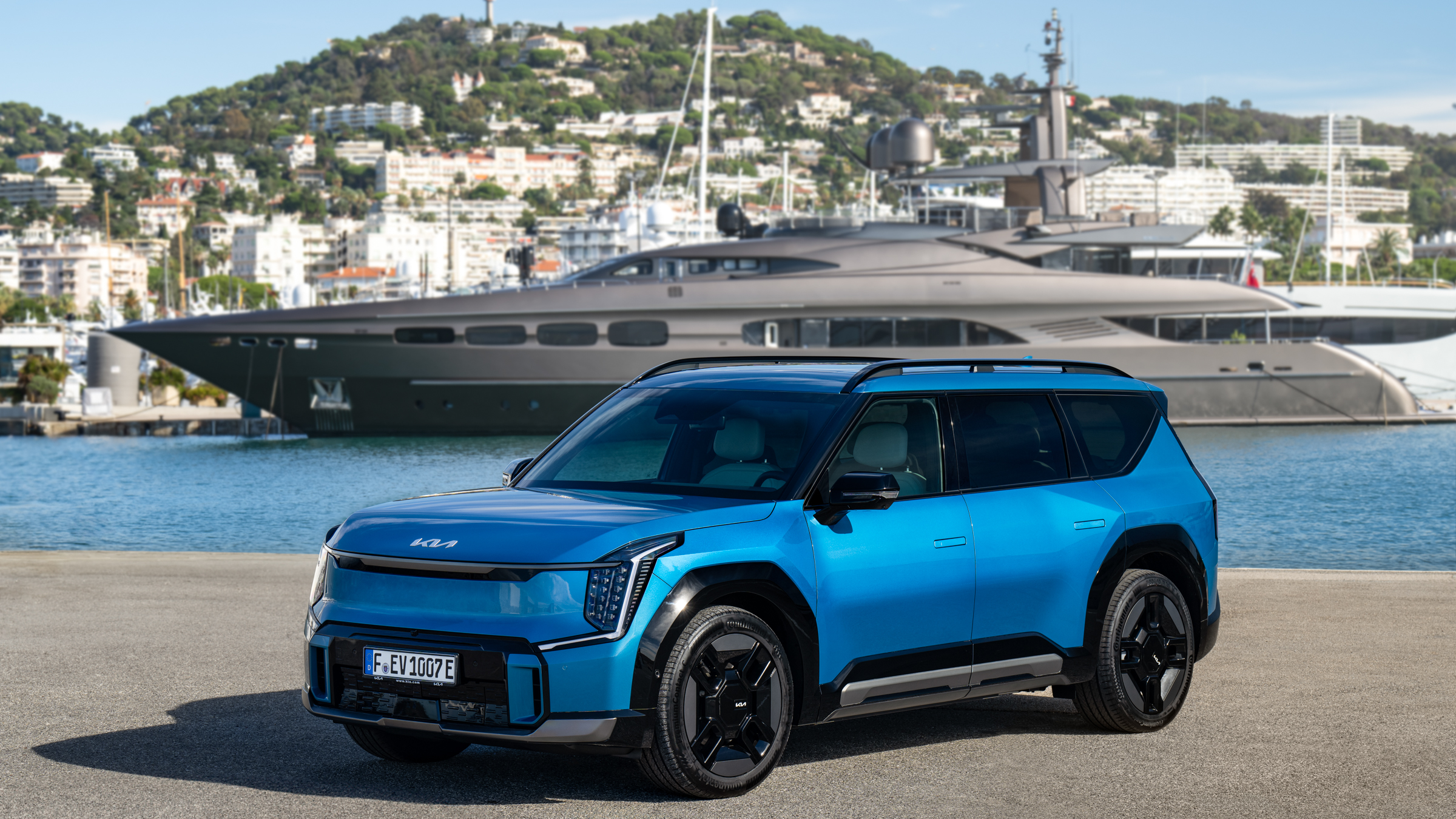
Only the range-topping dual-motor cars were available to drive at the EV9 launch, so I can’t say what the entry-level, single-motor car version is like. Its 0-62mph time of 9.4 seconds is pretty low by modern standards, but I imagine the 0-30 mph still feels brisk enough in most situations, and on paper at least it’s the model I would go for, given the lower price and higher range.
The dual-motor, GT-Line cars with Boost mode we drove at Kia’s event were, of course, outrageously quick in a straight line. No one needs a seven-seat family truck like this to hit 62 mph in 5.3 seconds, but automotive marketing teams just can’t help themselves.
Driven along a winding coastal road, the EV9 hides its weight pretty well. Ride quality is good, there isn’t too much roll in the corners, and nor does the front rise like a boat when accelerating. The double-glazed cabin is remarkably quiet, Kia has rightly resisted the urge to give the car a fake soundtrack (even in sport mode), and although too light in normal mode the steering feels precise enough. The EV9 does thump over speed bumps a little at low speed, but otherwise you’re mostly left unaware of its hulking proportions. At least until something’s coming the other way on a narrow street, of course.
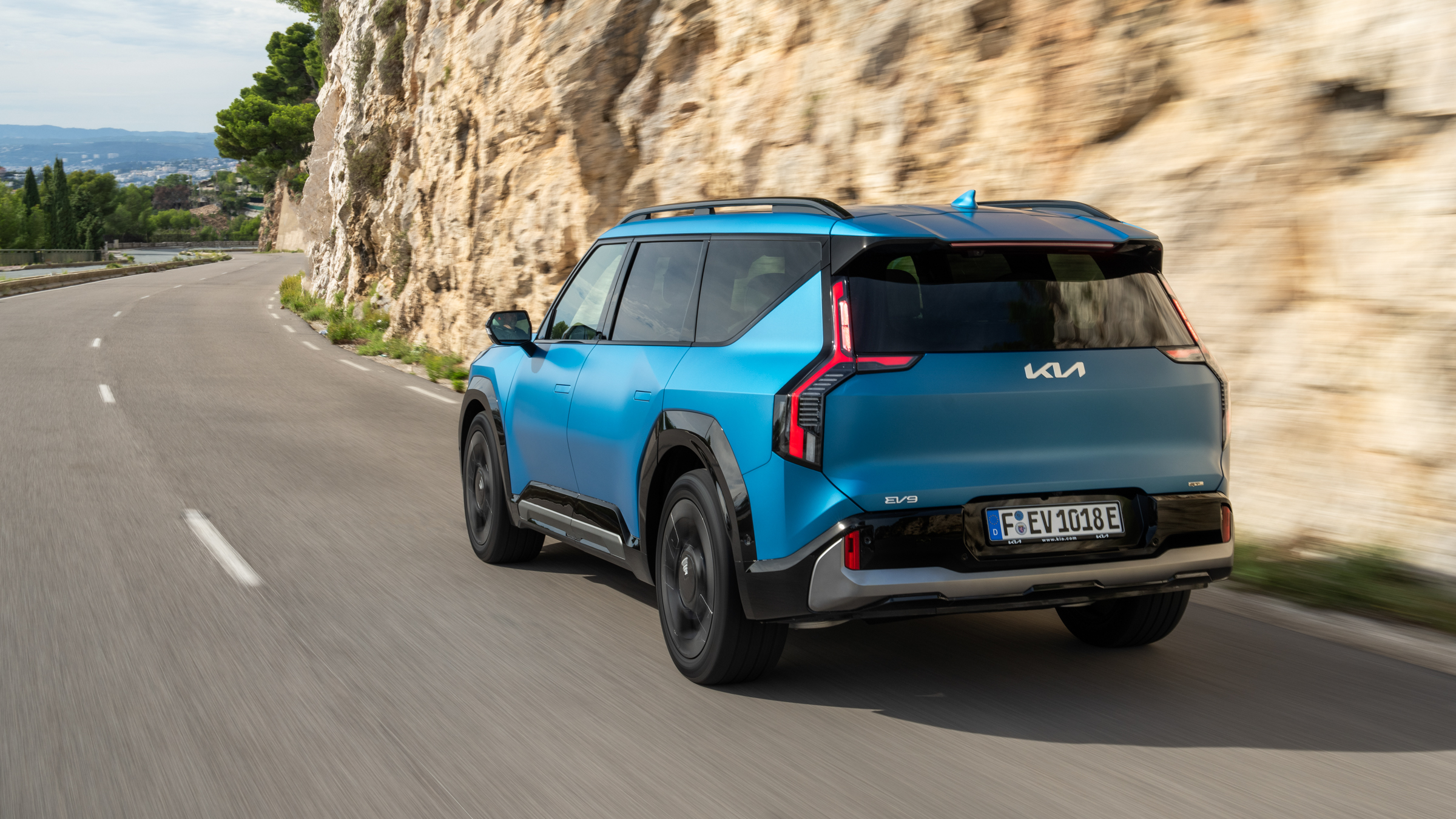
I like how Kia fits paddles behind the steering wheel to adjust the strength of the regenerative braking. There are three levels of resistance, plus a final fourth level that turns on one-pedal driving, where a full lift of the accelerator will bring the EV9 to a halt. The regen is rather strong, and I found myself flicking through all four levels quite regularly. Low regen works best on the motorway, for me at least, with stronger regen handy in town. The car lover in me enjoys how the paddles give the driver something to do, almost akin to changing gear.
Kia claims up to 318 miles of range for the dual-motor car and 350 for the single-motor. While I didn’t get to test this to the limit, my day with the EV saw an average energy consumption of 4.16 miles per kWh, which when multiplied by the 99.8 kWh of usable battery capacity means 415 miles of range.
That's almost 100 more than claimed, but I must caveat this by saying the driving route included very little motorway driving, with most of the journey taking place on roads with lower speed limits. Regardless, the EV9 put in a stellar performance.
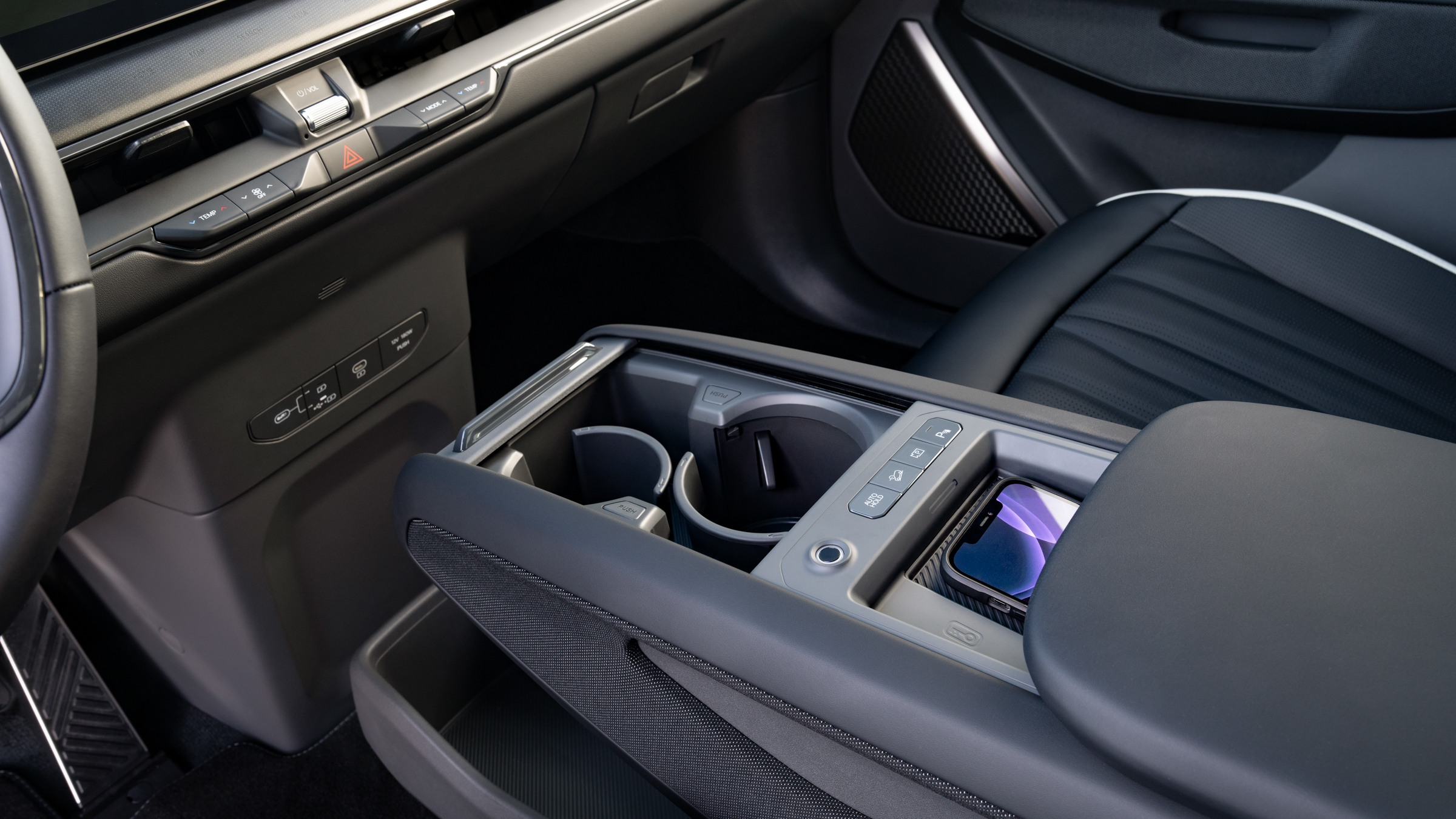
The EV9’s driver assistance systems, however, are hit-and-miss. We were encouraged by event staff to turn off the lane-keep assist function even before we had started our drive – and, sure enough, when we eventually tried it we found a system that often failed to read the white boundary lines of the road.
As with so many others, the tech often intervened in a heavy-handed manner – something that it does far too often, especially as we were driving a wide car on narrow roads. Occasionally crossing the nearside white line to make space for oncoming vehicles is a frequent necessity, but one which the system fails to grasp.
The EV9 failed to correctly identify speed limit signs – a pain when there’s also a system that warns you every time you exceed the limit – repeatedly warned of stop signs that weren’t for the lane I was driving in, and on several occasions the navigation system failed to identify junctions and the correct roundabout exit.
Unfortunately these are all issues the modern car driver must learn to live with, at least until they are patched with software updates.
Should I buy a Kia EV9?
Software annoyances aside, if you need a big electric car then you should absolutely consider the Kia EV9. It is smartly designed, feels well made and is powered by one of the best electric drivetrains of any manufacturer. The range and performance are both good, it’ll charge very quickly – as much as 155 miles in 15 minutes, Kia says – and there’s loads of kit fitted as standard.
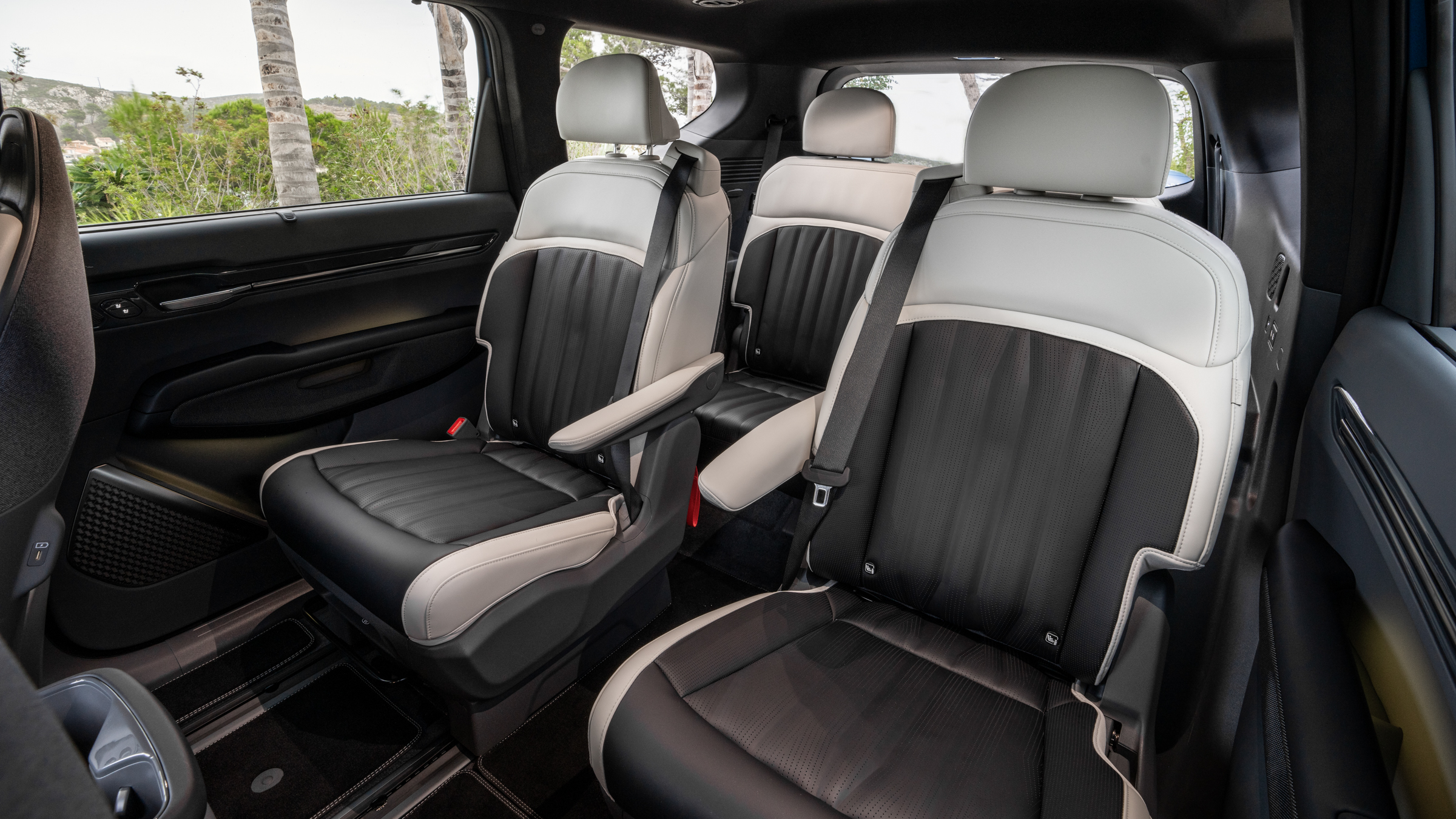
Go for the single-motor model to get maximum range, as I suspect for most drivers that car still offers enough performance. It’s just a shame the blue paint job is reserved for the dual-motor variant.
Kia has quickly become an EV force to be reckoned with, but remains a manufacturer that represents great value for money. With the EV9 it has yet another reason to keep European car makers up at night.
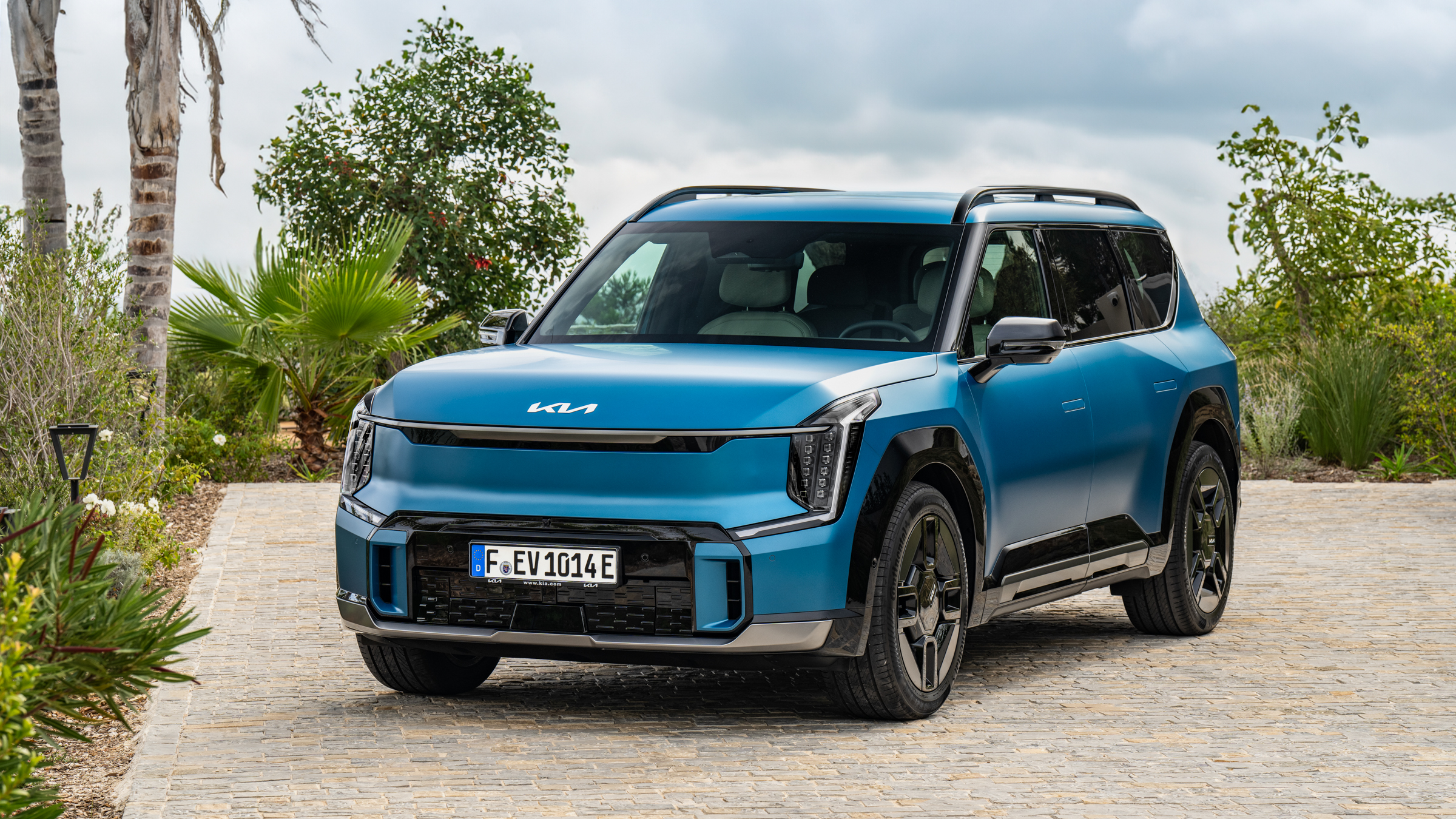
Looking for a home charger? Take a look at our best EV charger guide to find the right model for you.







